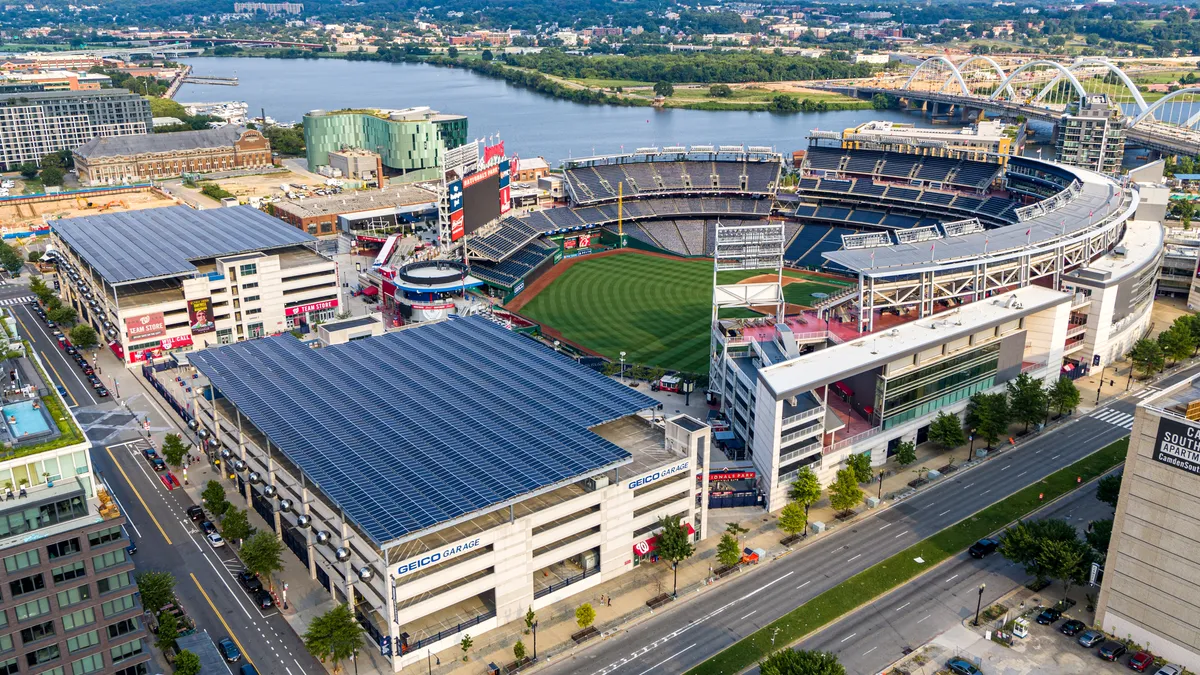The District of Columbia is committed to adhering to the CleanEnergy Omnibus Amendment Act of 2018 (CleanEnergy Act). The CleanEnergy Act codifies several key initiatives identified in the Clean Energy DC Plan, the District's detailed energy and climate action plan to cut greenhouse gas (GHG) emissions in half by 2032. The Act increases the District's Renewable Energy Portfolio Standard (RPS), setting the District on a path to 100% renewable energy by 2032, with 10% of electricity from solar by 2041.
As the utility regulator, the Public Service Commission of the District of Columbia (DCPSC) has an important role in helping the District achieve its energy and climate goals. The DCPSC considers the District's climate commitments when making policy decisions, which have created, expanded or enhanced several climate initiatives.
Consequently, the DCPSC has seen a significant increase in solar generation throughout the District and is setting clean energy policies and rules that bring stakeholders, policymakers, residents and businesses together to find innovative projects to meet the District's climate goals.
Pivoting to Solar
To help residents and businesses pivot to solar energy, the DCPSC has implemented an efficient, automated RPS application process. Last year, DCPSC staff received a record 2,835 applications through a new RPS certification portal. Willie L. Phillips, Chairman of the DCPSC, noted, "Over the past two years, staff has worked with outside stakeholders and the regulated electric distribution utility, Pepco, to further streamline the process."
The DCPSC will continue to enhance its RPS application process and rules related to small-generator interconnection standards for regulated utilities.
Promoting Solar
The DCPSC is also pursuing innovative solutions for residents. In 2020, the DCPSC implemented three changes to improve solar power adoption:
- Elimination of the requirement that a community renewable energy facility (CREF) connect directly to the distribution system. This change to the rules will facilitate the development of virtual CREFs, using a behind-the-meter (BTM) configuration that helps reduce costs while maintaining safety and reliability.
- Revision to net energy metering (NEM) rules allowing individual BTM generators to exceed 100% of customers' historical usage and customer payment for excess generation. Phillips explained, "A NEM system can increase the generation threshold by 20% annually, starting in 2020 until the generation threshold reaches 200% in 2024."
- Issuance of two Notices of Proposed Rulemaking to further enhance and accelerate interconnection for renewable energy facilities, including CREFs.
The DCPSC has made significant progress in certifying renewable energy facilities for the RPS program. Solar energy systems account for the vast majority of approved renewable systems, nearly 11,500 as of June 1, 2021, with 170.5 MW of capacity. The DCPSC has also certified 164 CREFs, with nearly 20 MW of capacity.
Partnering with Stakeholders
The DCPSC seeks to partner with stakeholders to ensure selected projects align with the PowerPath DC vision statement and guiding principles. The PowerPath DC Pilot Projects Governance Board was developed to support the DCPSC in allocating funds from the Pepco Holdings Inc.-Exelon merger toward energy system modernization pilot projects. Phillips said, "The DCPSC benefits from a broad range of expertise and insights from local D.C. organizations and agencies informing the development of these innovative projects."
The DCPSC also has a close relationship with the District Department of Energy and Environment and the DC Sustainable Energy Utility, which help residents, businesses and communities gain access to solar installations. "The DCPSC fully supports the DOEE initiated Solar for All program, which aims to provide 100,000 low-income families with locally generated clean energy and cut their energy bills in half in the process," stated Phillips.
Additionally, the DCPSC continues to push for renewable considerations with its utilities. The DCPSC recently established a pilot program to procure renewable energy supply through long-term PPAs for electricity generated by solar or wind power facilities in the PJM Interconnection region. Renewable energy supply from this pilot PPA is currently expected to begin serving the target quantity of 5% of SOS load around 2025. By integrating solar and renewable energy into Pepco's default service program, the DCPSC will advance the GHG reduction goal for the District while promoting the construction of new renewable facilities in the PJM region.
Finally, the DCPSC is working closely with a stakeholder group to develop the analytical approach that the DCPSC should take when considering the effects of a utility proposal on global climate change and the District's public policy commitments.
Conclusion
While the DCPSC has worked hard to establish solar power as a strong foundation to help the District meet the goals of the CleanEnergy Act, more work needs to be done.
In the next year, the DCPSC will authorize pilot projects and evaluate the commercial viability of those pilot projects, as well as update the interconnection rules to assure the expansion of solar opportunities for residential, commercial and community customers. In the longer term, the DCPSC will continue to take steps to achieve the PowerPath DC vision of a modernized grid, and these steps will also help facilitate the District in meeting its energy and climate policies set forth in statute and in its clean energy, climate and sustainability plans.










